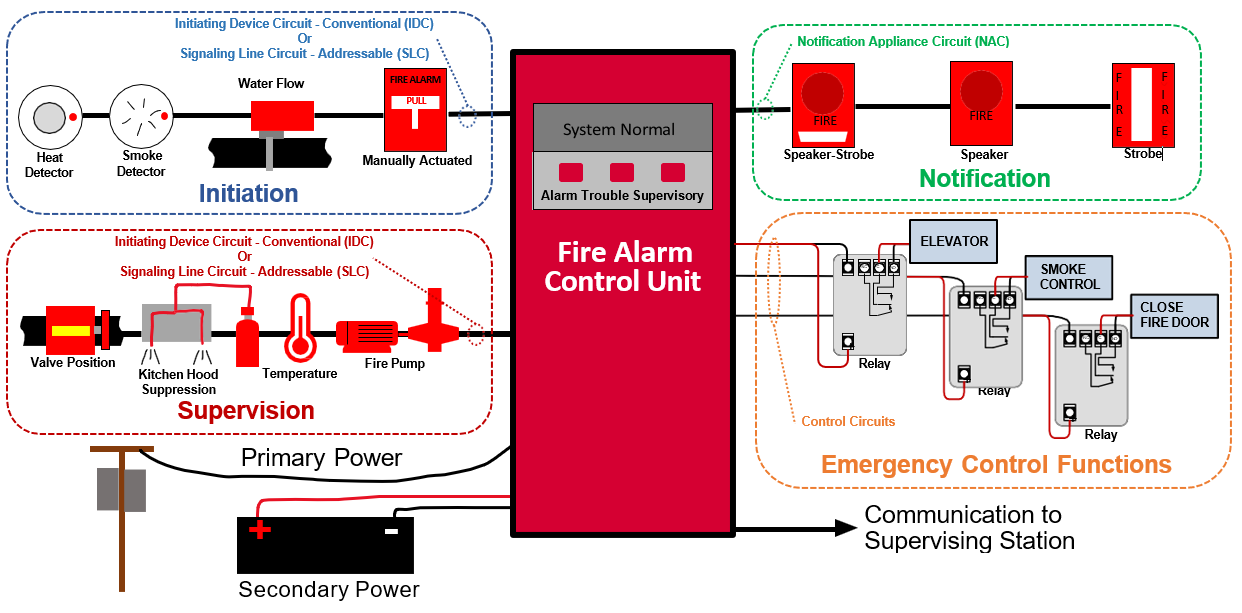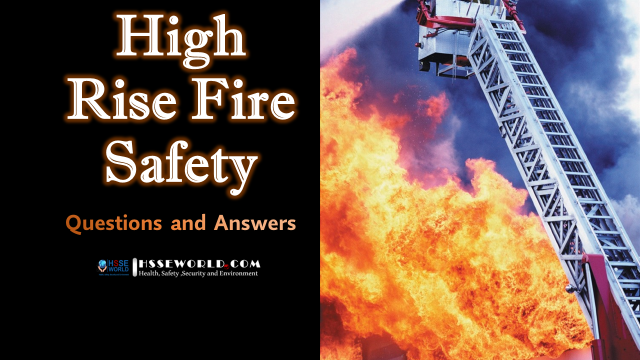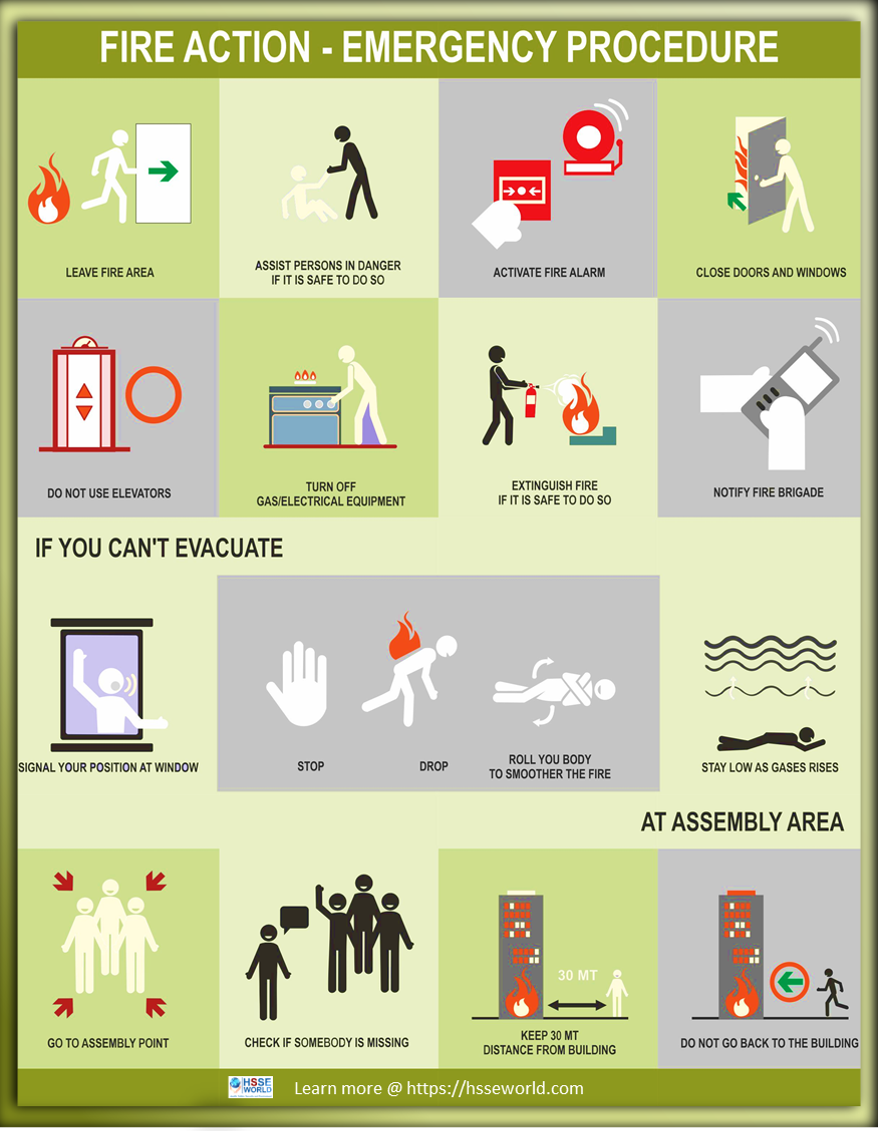Fire alarm system plays a crucial role in safeguarding lives and protecting properties by detecting and alerting occupants in the event of a fire. These systems are composed of various components and functions that work together seamlessly. In this blog, we will explore the basics of fire alarm systems, focusing on six key functions: initiation, supervision, power supply, notification, emergency control functions, and off-premises signalling and supervising stations. Let’s dive in!
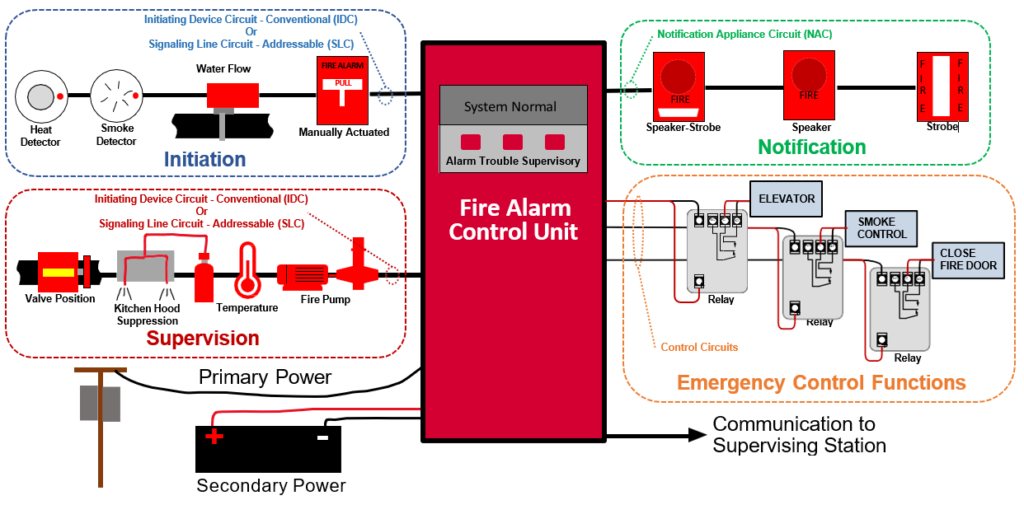
Introduction to Fire Alarm Systems and Their Importance
Fire alarm systems serve as critical safety components in both residential and commercial buildings. The primary function of these systems is to detect and warn occupants of the presence of fire, allowing for timely evacuation and emergency response. This early detection is crucial in mitigating the risks to human life and reducing property damage caused by fire.
The importance of fire alarm systems cannot be overstated:
- Life Safety: The most important function of fire alarm systems is to save lives. By providing early warning of a fire, they give occupants the maximum possible time to evacuate the premises safely.
- Property Protection: Timely alerts from fire alarm systems allow for quicker activation of firefighting measures, which can contain the fire and reduce the extent of property damage.
- Legal Compliance: In many regions, the installation of fire alarm systems is mandated by law for certain types of buildings, making their presence a legal requirement to meet safety regulations.
- Insurance Benefits: Many insurance companies offer reduced premiums on properties equipped with fire alarm systems, acknowledging the lowered risk of extensive damage due to early fire detection.
- Peace of Mind: Knowing that a building is equipped with a fire detection system can provide great comfort to occupants and owners, ensuring that there are measures in place to alert and protect in the event of a fire.
A comprehensive fire alarm system typically includes several components, each playing a pivotal role in the overall effectiveness of the system. Understanding these components is essential for anyone responsible for the safety of a property’s occupants and the integrity of its infrastructure. The following sections will explain five essential components of a fire alarm system, detailing their functions and significance within the larger safety network.
Definitions
FACU – Fire Alarm Control Unit
The fire alarm control unit serves as the brain of the fire alarm system by monitoring all the inputs and controlling all the outputs. Some may also refer to this as a fire alarm control panel or fire alarm panel. The different types of conditions that can be seen at the fire alarm control unit are alarm, supervisory, and trouble, these conditions can also result in a signal being sent to the supervising station.
Alarm
An alarm condition means there is an immediate threat to life, property, or mission. An example of this would be a smoke detector sending a signal to the fire alarm control unit that there is a presence of smoke, which would initiate notification to the occupants to evacuate.
Trouble
A trouble condition means there is an issue or fault with the fire alarm system. An example would be a break in an initiating device circuit. This would show up as a trouble signal on the control unit.
Supervisory
A supervisory condition means there is an issue with a system, process, or equipment that is monitored by the fire alarm control unit (see Part 2 on Supervision). An example of this would be a sprinkler system valve being closed, this would show up as a supervisory signal on the control unit.
Understanding the Fire Alarm Control Panel: The Brain of the System
At the heart of any fire alarm system is the Fire Alarm Control Panel (FACP), often described as the system’s brain. This pivotal component is responsible for monitoring the various environmental sensors, such as smoke and heat detectors, and initiating an appropriate response whenever a potential fire hazard is detected.
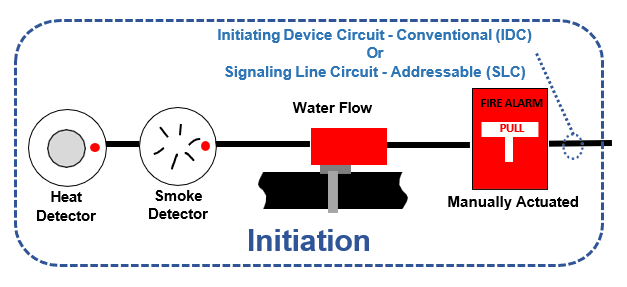
- Detection and Signaling: The FACP constantly communicates with the detection devices; it assesses signals and determines whether they meet the criteria for a fire alarm condition.
- Alerting Occupants and Authorities: Upon determining a fire condition, the FACP activates the building’s notification devices, like horns and strobe lights, to warn occupants to evacuate. It can also automatically alert emergency services.
- Monitoring System Integrity: This panel also continuously checks for faults or issues within the system, ensuring that issues such as disconnected sensors or low battery power are identified and can be addressed promptly.
- Manual Control: Fire Alarm Control Panels often provide manual controls, enabling authorized personnel to manage system functions such as disabling devices or silencing alarms when a false alarm occurs or after an incident has concluded.
Equipped with an interface, usually consisting of a display or a series of LEDs and a keypad or buttons, FACPs allow users to interact with and extract status reports from the system. Advanced panels might also include touchscreens and the ability to connect to computer networks for remote monitoring and control.
In larger facilities, the system might consist of several interconnected FACPs, creating a network that enhances coverage and reliability. Each panel can operate individually but shares information and collaborates when a fire is detected to ensure a cohesive and coordinated response across the entire facility.
On the whole, the FACP is the essential nerve centre, receiving, processing, and acting on information to ensure both the safety of a building’s occupants and the integrity of the fire alarm system itself.
Smoke Detectors and Heat Sensors: Detecting the First Signs of Danger
In the ambit of fire alarm systems, smoke detectors and heat sensors are fundamental in identifying the early stages of a fire, often before flames are visible. These devices are strategically installed throughout a structure to ensure maximum coverage and effectiveness.
Smoke detectors come in two primary types: ionization and photoelectric. Ionization smoke detectors respond faster to flaming fires with small particles, whereas photoelectric detectors are more responsive to smouldering fires producing larger smoke particles. Many modern systems opt for dual-sensor smoke detectors combining both technologies for a broad-spectrum detection capacity.
- Ionization Smoke Detectors: Quick to detect small particles typical of fast, flaming fires.
- Photoelectric Smoke Detectors: Sensitive to large particles from slower, smouldering fires.
- Dual-Sensor Smoke Detectors: Offer a combination of both detection methods.



- A beam smoke detector is like a photoelectric detector, except it is designed to cover a large area. A transmitter and receiver or reflector are placed to create a light beam across a space, when the amount of light being received by the receiver or reflected to the transmitter falls below a certain percentage, an alarm signal is sent.
Heat sensors, or thermal detectors, are equally crucial and generally come in two forms: fixed temperature and rate-of-rise. Fixed temperature sensors activate when a specific temperature is exceeded, while rate-of-rise sensors detect a rapid increase in temperature, irrespective of the baseline temperature, signalling a potential fire event.
- Fixed Temperature Sensors: Trigger at predetermined temperature thresholds.
- Rate-of-Rise Sensors: React to swift temperature spikes.
A non-restorable fixed temperature heat detector utilizes solder that holds up a plunger. The solder melts at a specific temperature and causes the plunger to drop, which shorts the contacts and causes an alarm signal.
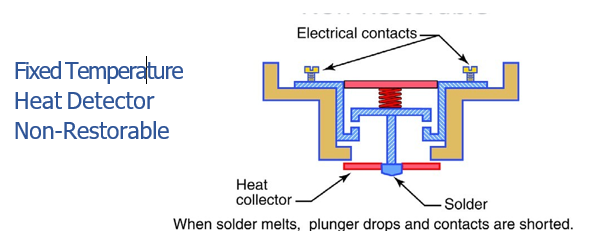
A restorable fixed-temperature heat detector utilizes two metals that have different thermal expansion coefficients. At a specific temperature, these metals will bend and cause the plunger to short the contacts, which causes an alarm condition. When the metal cools it will bend back in the other direction and restore itself.

A rate-of-rise detector utilizes an air chamber and a diaphragm. When a fire causes the air in the chamber to expand faster than it can escape out the vent, the increased pressure forces the diaphragm to close the contacts and initiate an alarm signal. This rate-of-rise detector also contains a fixed temperature plunger that will operate if the temperature exceeds the determined temperature.

It’s important to note that smoke detectors and heat sensors serve differently in various environments. Smoke detectors may be more suitable in residential areas or rooms with combustible materials, while heat sensors might be deployed in kitchens or industrial settings where smoke is a common but non-threatening occurrence.
For an efficacious fire alarm system, a combination of smoke detectors and heat sensors should be considered to cover a range of fire types and environmental conditions. This multi-layered approach can significantly enhance early fire detection, allowing for prompt evacuation and emergency response.
Flame Detectors and it’s applications
Manual Pull Stations: Human-Initiated Alerts

Manual pull stations are a critical interface between humans and the fire alarm system. These devices are strategically placed throughout a building to ensure that occupants have the immediate ability to alert others to the presence of a fire. Designed for quick recognition and ease of use, manual pull stations are typically found near exits and along escape routes. In the event of a fire, an individual can activate the alarm system by pulling down on the station’s handle—a simple yet intentional action that prevents accidental alarms.
Upon activation, manual pull stations send a signal to the fire alarm control panel, which in turn triggers the building’s audible and visual alarm devices. This rapid communication is essential for alerting occupants and allowing them the maximum amount of time to evacuate safely. Furthermore, the alert from a manual pull station can simultaneously notify emergency services, which hastens their response time to the fire emergency.
Key considerations in the design and implementation of manual pull stations include:
- Accessibility: Ensuring pull stations are reachable by all potential users, including those with disabilities.
- Visibility: Stations should be readily identifiable, often marked by a bright red color.
- Instructions: Clear instructions for operation are typically placed on or near the pull station to aid in prompt activation.
- Tamper Resistance: To prevent false alarms, manual pull stations are built to resist tampering and accidental activation.
- Compliance: These components must adhere to local fire codes and standards to ensure their reliability and effectiveness during a fire emergency.
Regular testing and maintenance are necessary to keep manual pull stations functional and responsive. Their role as a direct line to initiate a building’s emergency response plan makes them indispensable in the layered approach to fire safety.
Audible and Visual Notification Appliances to Ensure Evacuation
In the hierarchy of fire alarm system components, audible and visual notification appliances play a vital role in alerting building occupants to the presence of a fire, allowing for prompt and orderly evacuation.
Fire alarm – Audible Notification Appliances

The primary function of audible appliances, such as horns, bells, and chimes, is to emit a sound loud enough to alert all occupants within a building, regardless of their location. The design specifications often adhere to certain decibel levels and temporal patterns that distinguish the alarms from other background noises, ensuring recognition and response.
- Adherence to codes precisely dictates the placement of these appliances to cover all areas, including restrooms and other enclosed spaces.
- They often include voice evacuation messages to provide clear instructions, greatly enhancing egress efficiency during a fire event.
Fire alarm-Visual Notification Appliances
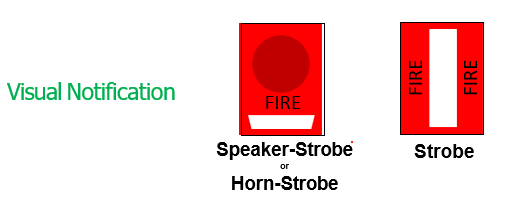
Visual notification, essential for the hard-of-hearing and in noisy environments, involves strobes or flashing lights that provide a visual alert of an emergency.
- The strobe synch feature ensures that the lights flash in unison, maximizing visibility and reducing the potential for disorientation or seizures in sensitive individuals.
- These appliances are strategically placed to be visible in all occupied spaces.
Read: E-Books: Evaluation of Fire Safety free download
Combined Systems
For effectiveness, many modern systems integrate both audible and visual notifications. This combination enhances the likelihood that all individuals, irrespective of their sensory perception capabilities, will receive a prompt warning.
- Integration of high-tech devices such as speakers with strobes is common in settings that require clear, intelligible voice announcements paired with visual cues.
- The design and installation take into account the acoustics and light levels of the environment to maximize alert effectiveness without causing unnecessary anxiety or confusion.
The effectiveness of audible and visual notification appliances lies in their ability to rapidly and clearly communicate the need to evacuate, ensuring minimal delay and maximum safety for building occupants during a fire emergency.
Monitoring Interface and Communication with Emergency Services
A comprehensive fire alarm system incorporates a sophisticated monitoring interface crucial for seamless coordination during an emergency. This component serves as the bridge between fire detection mechanisms and the necessary response teams. Consider the following functionalities integral to this aspect of a fire alarm system:
- Real-time Monitoring: The monitoring interface should enable real-time observation of the fire alarm status across different zones of the premises. It should provide instant alerts on the nature and location of the threat for prompt action.
- Remote Accessibility: Advanced systems often come with remote access capabilities, allowing security personnel or building managers to monitor the situation from any location, enhancing the speed and efficiency of the response.
- Automated Alerts: Upon detection of fire or smoke, the system should automatically notify the local emergency services. This automation ensures that even if the alarm goes unnoticed by occupants, help is still on the way.
- Two-Way Communication: Most modern systems feature two-way communication that allows direct dialogue with emergency responders. This communication channel can provide critical information about the situation before the responders arrive.
- Backup Communication Channels: In case of primary network failure, it is essential to have backup communication channels like GSM or radio frequency to maintain connectivity with emergency services.
- Maintenance Alerts: It should also send alerts for system maintenance or malfunctions to ensure uninterrupted protection.
The effectiveness of the monitoring interface is a testament to a well-integrated fire alarm system that not only detects fires but also facilitates swift intervention by emergency services, thereby mitigating potential losses of life and property.
Backup Power Supplies: Ensuring Functionality During Power Failures

In the event of a power outage, the reliability of a fire alarm system is heavily dependent on backup power supplies. These alternative power sources are critical for maintaining the functionality of the fire alarm system when the primary power is compromised.
Backup power supplies can take various forms:
- Uninterruptible Power Supplies (UPS): A UPS provides instant protection from power interruptions by supplying energy stored in batteries. The UPS allows the fire alarm system to continue operating without interruption during short-term power outages.
- Secondary Power Supply: This refers to batteries that are specifically designed to power the fire alarm system for an extended period after a power failure. Under normal conditions, these batteries are continuously charged by the main power source.
- Generator Systems: For prolonged power outages, buildings may be equipped with generators capable of supplying power to critical systems, including fire alarms, for an extended duration.
The functionality of backup power supplies is governed by various codes and standards, such as NFPA 72, which mandates that fire alarm systems must be able to operate on backup power for a minimum period—often 24 hours of standby operation followed by 5 minutes of alarm condition.
Regular maintenance is essential to ensure the backup power supplies are operational when needed. This includes routine testing, replacing batteries at the end of their service life, and ensuring generators have adequate fuel and are serviced according to the manufacturer’s recommendations.
In essence, backup power supplies are a fundamental component in the resilience of a fire alarm system, ensuring it remains fully operational during power failures—a critical safeguard for life and property.
Maintenance and Testing: Keeping the System Reliable
To ensure the optimal functioning of a fire alarm system, routine maintenance and testing are pivotal practices that cannot be overlooked. Here are the key factors involved in preserving the reliability of a fire alarm system:
- Regular Inspection: Fire alarm systems require regular inspections by professionals who can identify and address any potential issues. These inspections help ensure that all components, from smoke detectors to notification appliances, are working effectively and are in good repair.
- Cleaning: The components of a fire alarm system, particularly detectors, can accumulate dust and other contaminants which may affect their sensitivity and functionality. Regular cleaning helps maintain their precision in detecting fire-related incidents.
- Testing: Each component should undergo periodic testing to verify its operational capability. This includes:
- Simulated testing of smoke and heat detectors to ensure they activate appropriately.
- Checking manual call points and control panels for responsiveness.
- Verifying the sound level and audibility of alarms and public address systems.
- Batteries and Power Supply: Maintenance must include checking the batteries and power supply units to ensure they are capable of keeping the system operational during a power outage.
- Record Keeping: Maintaining accurate records of all maintenance, repairs, and testing activities is crucial. These records ensure compliance with regulatory standards and can be vital documentation in the event of a fire.
- System Upgrades: With technological advancements, systems periodically require updates or upgrades to enhance their reliability and comply with updated safety standards.
By incorporating these practices, facilities can maintain the integrity of their fire alarm systems and ensure that in the event of a fire, the system functions as the critical line of defence it is intended to be, facilitating timely evacuation and emergency response.
Integration with Sprinkler Systems and Other Fire Suppression Solutions
A critical aspect of a comprehensive fire safety plan is the seamless integration of fire alarm systems with sprinkler systems and other fire suppression solutions. Maximizing the efficacy of fire response measures necessitates that each component of the fire alarm system communicates effectively with fire suppression systems.
- Automatic Activation: Fire alarm systems are designed to automatically trigger the release of fire suppression agents. When smoke or heat detectors signal a fire event, sprinkler systems can activate immediately, providing rapid response to help control the spread of flames.
- Zoned Responses: Advanced fire alarm systems allow for zoned responses, where only the sprinklers in the affected area are activated, minimizing water damage and disruption. This targeted approach to fire suppression is vital for large facilities where extended activation could have significant consequences.
- Centralized Monitoring: A centrally monitored fire alarm system ensures that all fire response activities are overseen from a single location. This enables swift decision-making and deployment of additional fire suppression resources as needed.
- Early Suppression Fast Response (ESFR) Systems: Integration with ESFR systems, which are high-capacity sprinklers designed for specific hazards, further ensures that the response to a fire event is both appropriate and effective in minimizing damage and potential loss of life.
- Manual Overrides: While automated systems are crucial for immediate response, manual overrides are necessary for allowing human intervention when needed. Fire alarm systems typically incorporate manual stations for initiating or halting the suppression process.
- Maintenance Alerts: Fire alarm systems often include features that monitor the operational status of sprinkler systems, alerting maintenance personnel to any malfunctions or necessary inspections to ensure readiness at all times.
This integrated approach ensures that all systems work harmoniously, reducing reaction time, mitigating fire damage, and enhancing overall safety for both property and occupants. Every fire alarm system should be designed with this interconnected functionality in mind, tailored to the specific needs of the building it serves.
Compliance and Standards: Meeting Legal Fire Safety Requirements
Ensuring that a fire alarm system complies with legal fire safety standards is critical for the protection of lives and property. Each jurisdiction may have specific requirements that must be met, but there are common themes in the standards designed to ensure systems are reliable, effective, and maintained.
- National Fire Protection Association (NFPA): In the United States, the NFPA 72 National Fire Alarm and Signaling Code is the benchmark for the design, installation, and maintenance of fire alarm systems. It provides comprehensive standards for all aspects of fire detection, emergency communications, and signalling systems.
- Local Codes: Local fire codes and building regulations can vary significantly. It’s imperative for installers and property owners to be well-informed about the rules applicable in their area. Local codes often elaborate on or add to the requirements set forth by the NFPA.
- Installation Standards: Proper installation according to the manufacturer’s specifications and the prevailing codes is necessary to ensure the functionality and reliability of the system. Certified professionals should perform installations to guarantee compliance with all standards.
- Maintenance and Inspection: Regular maintenance and inspection are mandated by fire safety standards. These practices not only ensure ongoing compliance but are also critical in identifying and rectifying any potential issues before they lead to system failure during an emergency.
- Documentation: Keeping thorough documentation of installation, inspections, maintenance, and any modifications is not only a regulatory requirement but also serves as a record ensuring due diligence and responsibility have been followed.
- Certification and Approval: Fire alarm systems and components should have certification from recognized testing laboratories, such as Underwriters Laboratories (UL) or Factory Mutual (FM), asserting that they meet specific safety standards.
Failure to comply with these standards can result in legal consequences, including fines, facility shutdowns, and increased liability in the event of a fire. Furthermore, insurance companies may require proof of compliance to provide coverage. Therefore, the integration of compliance and standards into every component of a fire alarm system is not just a legal obligation but also a critical business practice.
Advanced Features and Technologies in Modern Fire Alarm Systems
In the forefront of fire protection technology, modern fire alarm systems are equipped with sophisticated features designed to offer enhanced safety and efficiency. These advanced components and technologies exemplify the significant strides made in fire detection and alarm systems.
- Addressable Devices: Unlike traditional systems where alarms are generalized to an area, addressable systems allow each detection device to have a unique identifier. This pinpoint identification helps in quickly locating the specific area of alarm, thus facilitating faster response times.
- Wireless Connectivity: With the integration of wireless technology, modern fire alarm systems can be installed with minimal disruption to a building’s structure. This is particularly useful in historical buildings or spaces where running extensive wiring is not feasible or preferred.
- Voice Evacuation Systems: Rather than just blaring sirens, these systems provide pre-recorded or live voice instructions to facilitate orderly evacuation. Voice evacuation systems are known to be more effective in guiding people, especially in complex or large buildings.
- Mass Notification Systems (MNS): MNS are designed to communicate emergency information quickly and efficiently not just within the building but across multiple platforms such as SMS, email, and social media to reach people who might be affected but are not presently in the alarmed area.
- Integration with Building Automation: Smart systems integrate fire alarm technology with building automation systems (BAS). These integrations can control ventilation systems to inhibit smoke spread, shutdown electrical equipment to prevent further hazards, and interface with security systems, ensuring a more coordinated emergency response.
- Cloud-based Monitoring: Enables remote monitoring of the fire alarm system through cloud technology. This feature allows facility managers and maintenance teams to receive instant notifications on their devices about system status, maintenance issues, or alarms, facilitating an immediate response even when off-site.
Choosing the Right Fire Alarm System for Different Building Types
In the pursuit of safety, selecting an appropriate fire alarm system tailored to the specific needs of a building is of utmost importance. Different types of buildings necessitate diverse fire alarm configurations and technologies to ensure optimal protection. ( read: Basic guidelines for selection of fire and Gas detectors )
Residential Buildings
For residential buildings, especially single-family homes, basic fire alarm systems that include smoke detectors and audible notification appliances are usually sufficient. The primary goal is to alert the occupants quickly enough to allow for safe evacuation.
- Smoke detectors should be installed in every bedroom, outside each sleeping area, and on every level of the home.
- Consider interconnected smoke alarms that, when one sounds, all sound simultaneously, providing quicker notification throughout the house.
Commercial Buildings
Commercial buildings, including offices and retail spaces, require more advanced systems equipped with smoke and heat detectors, manual pull stations, and a central monitoring panel.
- The system should be designed to not only facilitate evacuation but also allow for fire department notification and potential suppression system activation.
- Zoning capabilities are key, as they help in identifying the specific location of a fire within the building.
Industrial Facilities
Industrial buildings present a unique set of challenges due to potentially hazardous materials, high ceilings, and vast open spaces.
- Systems for these buildings should include rate-of-rise heat detectors, flame detectors, or specialized smoke detectors that can handle the environmental conditions.
- The alarm system must be integrated with the building’s control system for specific actions like machinery shutdown or activation of ventilation systems.
High-Rise Buildings
High-rises demand highly sophisticated fire alarm systems with voice evacuation procedures, control panels on multiple floors, and integration with other safety systems.
- Strobes and speakers are placed throughout the building, including stairwells and elevators, to ensure that the alarm is heard by all occupants.
- Voice evacuation messages must be clear and instruct on the safest exit routes.
E-Books: Fire Service Features of Buildings and Fire Protection Systems
Read: High Rise Fire Safety Questions and Answers
Educational and Healthcare Facilities
These buildings must have systems that account for the diverse range of occupants, including individuals with mobility or sensory impairments.
- Visual alarms and public address systems are essential for providing adequate warning.
- Phased evacuation alert systems, which evacuate people in stages to prevent overcrowding of exit routes, are recommended for these complex facilities.
Each building type provides specific challenges and requires a bespoke approach to fire alarm systems to ensure the safety of its occupants and to comply with the relevant fire safety regulations.
Conclusion: The Critical Role of Fire Alarm Systems in Safety Planning
Fire alarm systems hold a pivotal role in the overarching strategy of safety planning in any building or establishment. The protection they offer not only encompasses the preservation of life but also extends to the mitigation of property damage. In a cohesive fire safety plan, these systems work tirelessly as the first line of defence, providing the critical early warning needed to facilitate the safe evacuation of occupants and prompt the action of emergency services.
Comprehensively, fire alarm systems integrate a network of devices, including smoke detectors, heat detectors, manual call points, audible alarming devices, and control panels, all functioning in consort to ensure the quickest response to the presence of fire. Their continual monitoring and immediate signalling of danger allow for swift, organized responses that can save countless lives.
In high-risk environments, the presence of an advanced fire alarm system is indispensable. It serves to not only alert occupants but also automatically trigger suppression systems which can control or extinguish fires before they spread uncontrollably. Furthermore, they are crucial for informing the relevant authorities, thereby expediting specialized and equipped interventions that can make a significant difference in the severity of the fire’s impact.
Without this vital component of safety planning, the risk of catastrophic aftermath in the event of a fire escalates dramatically. It is incumbent upon business owners, safety officers, and residential property managers to ensure that their fire alarm systems are not only present and functional but also regularly inspected, maintained, and updated to adhere to the highest standards of safety and technology.
In conclusion, the integration and proper management of fire alarm systems are not just regulatory requirements but essential duties toward the protection of lives and assets, highlighting their imperious role in any effective safety planning checklist.

